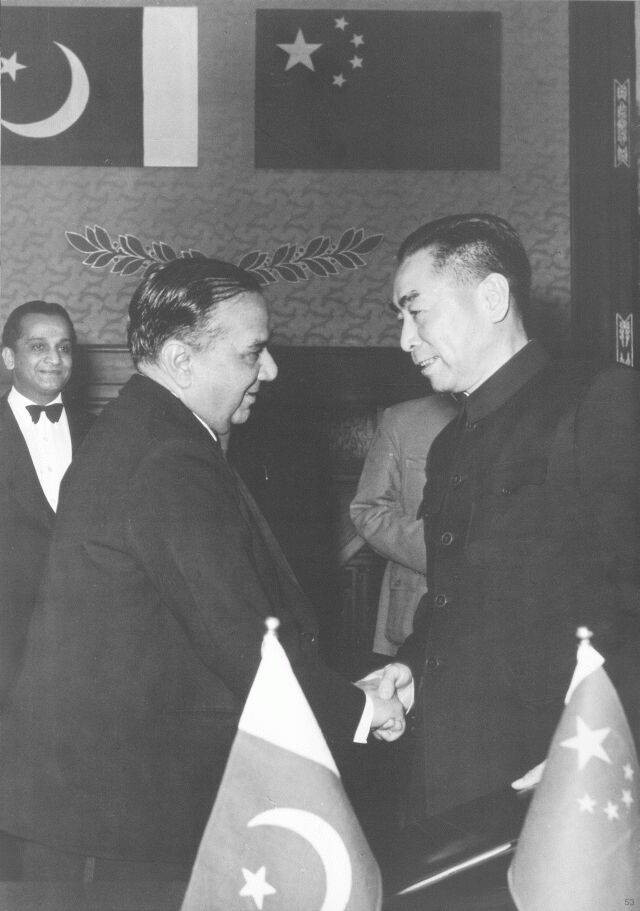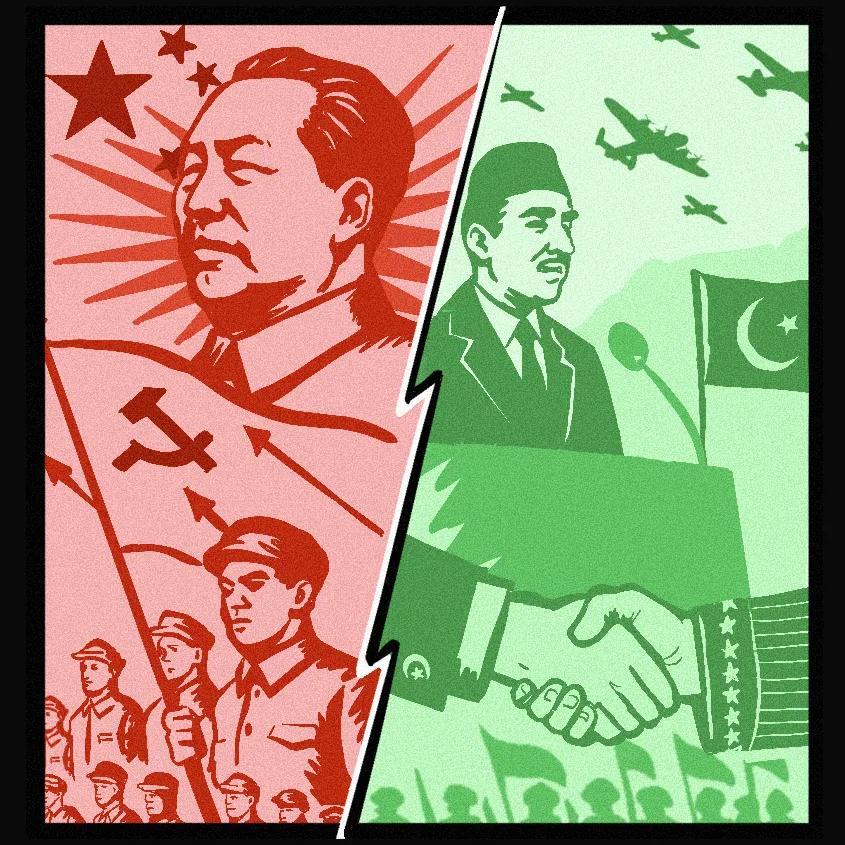The diplomatic slight was subtle but unmistakable. In November 1951, as Major General Nawabzada Agha Mohammad Raza presented his credentials as Pakistan’s first Ambassador to China, Chairman Mao Zedong’s carefully chosen words carried a clear message: “I have great pleasure in receiving the letters of credentials of the King of Great Britain, Ireland, and the British dominions beyond the seas, presented by you.” Notably absent was any mention that the Ambassador represented Pakistan itself. As one Indian diplomat gleefully observed at the time, this deliberate omission showed Beijing’s lukewarm attitude toward its new Muslim neighbour—an attitude that would persist as both countries drifted toward opposing sides of the Cold War’s great divide.
This period of estrangement, spanning roughly from 1950 to 1962, represents one of the most paradoxical chapters in what would eventually become the ‘Iron Brotherhood’ between China and Pakistan.
Despite Pakistan’s early recognition of the People’s Republic and Beijing’s measured response to Islamabad’s Western alignment, the relationship remained characterised by mutual wariness, competing strategic priorities and fundamentally different approaches to the emerging Cold War order. Yet it was precisely this period of divergence that would lay the groundwork for the enduring partnership that followed, as both countries learned valuable lessons about the limits of ideological alignment and the enduring importance of pragmatic statecraft.
A Hesitant Beginning
While Pakistan had moved quickly to become the first Muslim country to recognise Mao’s government, both sides approached the new relationship with notable caution.
This hesitation manifested in several telling ways. Despite their mutual recognition, it took over a year for the two countries to exchange ambassadors. Ghulam Ali, in the book China-Pakistan Relations: A Historical Analysis, writes that when People’s China began publication, its coverage reflected Beijing’s lukewarm interest in its new Pakistani partner. Stories about India dominated its Asian coverage, while Pakistan barely merited mention. The first substantive story on Pakistan appeared only in 1953, three years after diplomatic recognition.
The reasons for this mutual indifference were rooted in the geopolitics of the early 1950s. Pakistan remained a dominion of the British Empire until 1956, a status that complicated its claim to full sovereignty in the eyes of a revolutionary Chinese leadership eager to break free from Western influence. More significantly, Pakistan’s ruling elite was already contemplating a strategic alignment with the United States, a development that would place it squarely in opposition to China’s own security interests.
The divergent paths became clear as early as 1949, when Pakistan’s first Prime Minister, Liaquat Ali Khan, faced nearly simultaneous invitations from both Moscow and Washington. His decision to accept the American invitation while setting aside the Soviet one signalled Pakistan’s Western orientation and foreshadowed the strategic choices that would define the next decade of Sino-Pakistani relations.
Choosing Sides in the Cold War
By the mid-1950s, the ideological and strategic gulf between China and Pakistan had widened into a seemingly unbridgeable chasm. The Cold War’s bipolar structure demanded clear allegiances, and both countries chose sides that placed them in opposing camps. China’s entry into the Soviet-led Communist bloc was matched by Pakistan’s increasingly robust embrace of American-led containment strategy.
Pakistan’s move from a non-aligned country to a key Western ally began in earnest with the signing of the United States-Pakistan Mutual Defence Assistance Agreement in May 1954. Under this agreement, Washington committed to providing $430 million in military aid, turning Pakistan into what American strategists viewed as a crucial link in the chain of containment around the Sino-Soviet bloc. This was merely the beginning of Pakistan’s integration into Western security architecture.
The scope of Pakistan’s Western alignment became apparent as Islamabad joined a series of anti-Communist alliances. It became a founding member of the Baghdad Pact alongside Turkey, Iran and Iraq, creating a Western-supported security arrangement in the Middle East. When the Southeast Asian Treaty Organization (SEATO) was established following the 1954 Geneva Conference to guarantee Southeast Asian nations against Communist expansion, Pakistan eagerly joined. By 1959, Pakistan had signed four separate defence pacts with the United States, some explicitly anti-China and anti-Communist in their orientation.
This Western alignment represented a dramatic abandonment of Pakistan’s earlier non-aligned stance and positioned it as one of America’s most important military partners in Asia. At the United Nations, Pakistan consistently supported American efforts to keep the PRC from assuming China’s seat, further cementing its role as a Western ally in the ideological struggle against Communism.
By the mid-1950s, the ideological and strategic gulf between China and Pakistan had widened into a seemingly unbridgeable chasm. The Cold War’s bipolar structure demanded clear allegiances, and both countries chose sides that placed them in opposing camps. China’s entry into the Soviet-led Communist bloc was matched by Pakistan’s increasingly robust embrace of American-led containment strategy.
Beijing’s Measured Response
What distinguished China’s reaction to Pakistan’s Western alignment from that of other Communist powers was its restraint. While the Soviet Union responded to Pakistan’s defence agreements with increasingly hostile rhetoric and diplomatic pressure, China maintained what scholar Anwar Syed described as criticism “remarkable for their moderation.”
Chinese state media did express concerns about Pakistan’s strategic choices, but these criticisms were carefully calibrated to avoid permanent damage to bilateral relations. Most of China’s criticism focused on American intentions rather than Pakistani motives. Beijing consistently portrayed Pakistan as a victim of American manipulation rather than a willing participant in anti-Chinese activities. The PRC argued that through these agreements, the United States was attempting to “sow discord among Asians and to prevent them from cooperating with one another in mutually beneficial ways.”
This measured approach stood in stark contrast to Soviet behaviour during the same period. Moscow’s reaction to Pakistan’s Western alignment was swift and punitive. The USSR began openly supporting India and Afghanistan in their disputes with Pakistan, abandoned its previously neutral stance on Kashmir to back New Delhi’s position, and actively promoted the creation of ‘Pakhtoonistan’ to pressure Pakistan on its northwestern frontier.
The Strategic Calculus
According to Ghulam Ali, China’s restrained response to Pakistan’s Western alignment reflected several important strategic calculations that would prove crucial to the eventual development of their partnership. First, Beijing was dealing with internal challenges during this period, including the massive social and economic transformation required by the Communist revolution. Chinese leaders could ill afford to create additional external enemies when domestic priorities demanded their attention.
Second, and perhaps more importantly, Chinese strategists recognised that Pakistan’s primary security concern was India, not China. Unlike other American allies who might genuinely threaten Chinese interests, Pakistan’s Western alignment was fundamentally defensive in nature, aimed at balancing Indian power rather than containing Chinese influence. This understanding allowed Beijing to view Pakistan’s strategic choices with greater equanimity than it might otherwise have shown.
Third, Premier Zhou Enlai’s genuine commitment to good relations with neighbouring countries influenced Chinese policy toward Pakistan during this period. According to Chinese diplomatic sources, Zhou believed that maintaining cordial relations with neighbouring states, even those aligned with opposing blocs, served China’s broader strategic interests in establishing itself as a responsible regional power.
The wisdom of this patient approach became apparent as the 1950s progressed and cracks began to appear in Pakistan’s Western alignment. Various circles within Pakistan, particularly in the business and industrial sectors, began questioning the necessity and cost of the country’s extensive defense commitments. These concerns intensified following Soviet Premier Khrushchev’s warnings to Pakistan during his visit to India, which created what Pakistani observers described as a “sense of isolation and of being surrounded by powerful enemies and supported by uncertain allies, who are too far away or unwilling to render immediate assistance.”
Most of China’s criticism focused on American intentions rather than Pakistani motives. Beijing consistently portrayed Pakistan as a victim of American manipulation rather than a willing participant in anti-Chinese activities.
Approaches to Regional Conflicts
The period of Cold War divergence also revealed fundamental differences in how China and Pakistan approached regional conflicts, particularly the Kashmir dispute. These differences illustrated the broader ideological and strategic gaps that separated the two countries during this formative period.
Pakistan’s approach to Kashmir reflected its status as a newly independent state struggling to establish its legitimacy and territorial integrity. Following its first war with India in 1948, Pakistani leaders recognised their country’s limitations in resolving the dispute through bilateral negotiations. Consequently, Pakistan pursued a multilateral strategy, seeking support from the United Nations, the United States, Commonwealth nations and Muslim countries worldwide.
This approach directly contradicted Chinese ideological preferences during the early Cold War period. Beijing regarded most of Pakistan’s chosen forums, particularly the UN and the United States, as imperialist institutions or their tools. From China’s perspective, Pakistan’s strategy risked opening the door to imperialist intervention in South Asian affairs, potentially compromising the region’s independence and self-determination.
China advocated instead for direct negotiations between Asian nations without external interference, consistent with the principles of Afro-Asian solidarity that would later be codified at the Bandung Conference. This approach reflected China’s broader foreign policy philosophy of opposing imperialist influence while promoting South-South co-operation among newly independent nations.
The disagreement over Kashmir resolution strategies revealed deeper philosophical differences about sovereignty, self-determination and the role of external powers in regional conflicts. While Pakistan viewed international engagement as necessary for achieving justice, China saw it as potentially compromising Asian independence and dignity.
Foundations of Future Partnership

Despite the apparent contradictions and tensions of this period, the years of Cold War divergence actually established several important precedents that would facilitate the eventual Sino-Pakistani rapprochement. China’s restrained response to Pakistan’s Western alignment demonstrated Beijing’s ability to separate immediate tactical disagreements from longer-term strategic potential. This patience prevented the kind of permanent rupture that might have foreclosed future co-operation.
Similarly, Pakistan’s experience with the limitations of Western alliance began to generate domestic constituencies favouring greater foreign policy flexibility. The realisation that distant allies might not provide reliable support in regional conflicts created space for alternative partnerships that could better serve Pakistani security interests.
The period also established important patterns of mutual respect despite ideological differences. China’s criticism of Pakistani policies focused on their external consequences rather than questioning Pakistan’s right to make sovereign choices. This approach preserved Pakistani dignity while expressing Chinese concerns, creating a foundation for future dialogue based on mutual respect rather than ideological conformity.
Perhaps most importantly, both sides demonstrated their ability to maintain diplomatic relations even under adverse circumstances. The fact that neither country severed diplomatic ties or engaged in hostile rhetoric, despite their fundamental disagreements, suggested a pragmatic approach to international relations that would serve both countries well in future decades.





